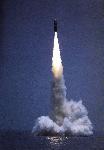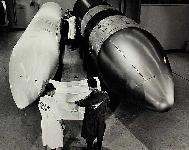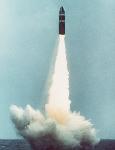





On 18 January 1965, President Lyndon B. Johnson announced in a special message to the Congress that his administration proposed to develop a new missile for the FBM System POSEIDON. The POSEIDON C3 was to be 74 in. in diameter as compared to the 54 in. POLARIS. It was to be 3 ft longer than the 31 ft A3 and approximately 30,000 lb heavier. Despite this increase in size, the growth potential of the ballistic missile submarine launching system was to enable POSEIDON to fit into the same 16 launch tubes that carried POLARIS; modifications to the launch tubes and a new fire control system for the more complex MIRV targeting problem were to be required. POSEIDON was to carry twice the payload of the POLARIS A3 with significantly-improved accuracy.
The Poseidon C3 was a two-stage solid propellant missile with a length of 34.1 ft. 74 in. diameter with a range of approximately 2500 nm, weight of approximately 65,000 lb. The ES (forward of the SS) is 72 in. in diameter which separates from the booster. It is equipped with the missile all inertial guidance system, a solid-propellant gas generator PBCS and RVs. This provides maneuvering of the ES and ejection of reentry vehicles into ballistics trajectories to individual targets, MIRVs. Both rocket motors have fiberglass cases, with single movable nozzles. The second stage motor had six thrust termination ports (thrusting forward) which are activated at ES separation. Multiple individual-targeted small reentry vehicles (Mk 3) were developed as the POSEIDON payload.
The POSEIDON C3 could carry up to 14 of the small Mk 3 RVs. These could be targeted bodies and could be targeted independently in the MIRV mode. Trajectory loft options were available, and the range could be extended by off-loading portions of the payload. The Post Boost Control System (PBCS), colloquially known as the "Bus," gave a large attack The increased accuracy and flexibility of the weapon system would permit its use against a broader spectrum of possible targets and give added insurance of penetration of enemy defenses. As envisioned at that time, POSEIDON was to increase the system and force effectiveness of the FBM System by a factor of eight. This revolutionary multiple target per missile concept changed the course of national policy, strategic force structures, targeting doctrines, and operational planning. It also altered the quantitative and qualitative strategic balance.
Apart from the much-increased size and weight, the main difference between the POLARIS A3 and the POSEIDON C3 was the latter's capability of delivering reentry vehicles to single or multiple targets. Thus the principal area of development involved flight of the ES with the guidance system and reentry vehicles after they had separated from the booster. The ES's solid-propellant gas generator and associated steering capability allowed the guidance system to maneuver the ES and to eject reentry vehicles into ballistic trajectories to individual aim points.
Development of propulsion for C3 was undertaken by a joint venture of Hercules, Inc., and Thiokol Chemical Corporation. Both stages now had fiberglass cases. The first stage used a composite propellant and the second stage propellant was a double base. The C3 rocket motors were the first in the FBM program to feature single-movable nozzles actuated by a gas generator and by hydraulic power units.
Other work centered on the development of an advanced all-inertial guidance system. Initial evaluations of a stellar-inertial guidance system were conducted in early 1966. Advanced development of a Mk 4 stellar-inertial guidance system was started in 1968. This effort was of an essential element of a new operational capability which became fully matured in the TRIDENT I and II.
Lockheed entered a 1 year Concept Design Phase (CDP) from February 1965 to February 1966. In March 1966, full-scale engineering development (FSED) began. However it was not until 12 March 1968 that a contract was executed. The Navy awarded Lockheed Missiles & Space Company, Inc. (LMSC) a $456.1 million cost-plus-incentive fee contract for development and production of the POSEIDON missile system. The contract represents one of the first awards made by the Navy Department providing for total operational system development and production (OSDP).
The contract called for 25 development (C3X) type flights to be followed by 5 Production Evaluation Missile (PEM) flights from an SSBN. The first C3X was launched from a flatpad at Cape Kennedy on 16 August 1968 several hours before the first Minuteman III launch. In view of the initial success of the development flights, the test plan was modified to 20 development flights versus 25. The PEMs remained at 5. Of these 20 flights, 13 were complete successes and 7 were failures. The last C3X flight was on 29 June 1970. This was followed on 17 July 1970 by the firsts submerged launch of a POSEIDON PEM successfully conducted from the USS James Madison (SSBN-627). The firing was observed by a Russian ship, LAPTEV, whose crew was unsuccessful in attempts to recover closure plate segments from the water after launch of the missile. The remaining 4 PEMs were also successfully launched from the SSBN-627.
Finally on 31 March 1971, the USS James Madison (SSBN-627) deployed from Charleston, South Carolina, for operational patrol with 16 tactical POSEIDON C3 missiles. Deployment of the USS James Madison (SSBN-627) introduced the POSEIDON missile into the nation's arsenal of operational deterrent weapons and brought to successful fruition the development program announced in January 1965 for a successor weapon system to POLARIS. POSEIDON incorporated substantial improvements in accuracy and resistance to counter-measures over previous generations of missiles, but its principal advantage was in its flexibility, which provided a capacity for delivery for multiple warheads, widely spaced, on separate targets over a variety of target footprints.
Specifications |
|






